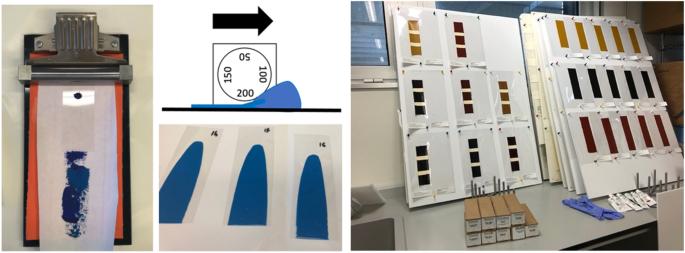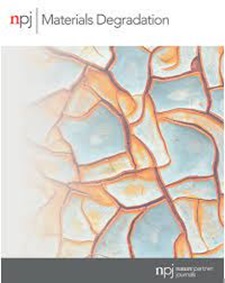油漆薄膜干燥和降解初期的离子迁移机制
IF 7.6
2区 材料科学
Q1 MATERIALS SCIENCE, MULTIDISCIPLINARY
引用次数: 0
摘要
在过去十年中,对油画颜料成膜过程的研究得到了广泛的关注,金属离子在油画颜料干燥和降解阶段的影响也得到了证实。本研究旨在确定一种合适的方法来监测选定的商用油漆薄膜的早期干燥阶段,并深入了解相邻漆膜之间发生的材料降解迁移机制,特别关注铅白的影响。为此,我们采用了一种混合方法来确定油漆成分的特征,并突出漆膜在不同时间段内的失效机制。这些方法包括划线测试、重量变化百分比(ΔW%)、衰减反射傅立叶变换红外分光光度法(ATR-FTIR)、气相色谱-质谱法(GC-MS)和差示扫描量热法(TG-DSC)。结果显示了金属离子如何与油粘合剂和相邻漆膜中的颜料相互作用:铅白的横向迁移影响了多不饱和甘油三酯的反应性,增加了氧气的吸收率,促进了自由基和聚合物链之间键的形成,具体取决于与之相互作用的颜料。本文章由计算机程序翻译,如有差异,请以英文原文为准。

Ion migration mechanisms in the early stages of drying and degradation of oil paint films
The study of film-formation processes of oil paints has been extensively addressed over the last decade and the influence of metal ions in the drying and degradation stages of oil paints has been demonstrated. This research aimed to determine a suitable methodology for monitoring the early drying stages of selected commercial oil paint films and to gain an insight into the migration mechanisms of material degradation taking place between adjacent paint films, with special attention to the influence of the lead white. For this purpose, a hybrid approach was adopted to characterize the composition of the paint and highlight failure mechanisms in the paint films through a wide range of time. The methods included scribe tests, percentage weight variation (ΔW%), attenuated reflectance Fourier transform infrared spectrophotometry (ATR-FTIR), gas chromatography-mass spectrometry (GC-MS), and thermal analysis with differential scanning calorimetry (TG-DSC). The results show how metal ions interact with the oil binder and the pigment in the adjacent paint film: the transverse migration of lead white is shown to affect the reactivity of polyunsaturated triglycerides, increasing the rate of oxygen uptake and promoting the formation of radicals and bonds between polymer chains, depending on the pigment with which it interacts.
求助全文
通过发布文献求助,成功后即可免费获取论文全文。
去求助
来源期刊

npj Materials Degradation
MATERIALS SCIENCE, MULTIDISCIPLINARY-
CiteScore
7.80
自引率
7.80%
发文量
86
审稿时长
6 weeks
期刊介绍:
npj Materials Degradation considers basic and applied research that explores all aspects of the degradation of metallic and non-metallic materials. The journal broadly defines ‘materials degradation’ as a reduction in the ability of a material to perform its task in-service as a result of environmental exposure.
The journal covers a broad range of topics including but not limited to:
-Degradation of metals, glasses, minerals, polymers, ceramics, cements and composites in natural and engineered environments, as a result of various stimuli
-Computational and experimental studies of degradation mechanisms and kinetics
-Characterization of degradation by traditional and emerging techniques
-New approaches and technologies for enhancing resistance to degradation
-Inspection and monitoring techniques for materials in-service, such as sensing technologies
 求助内容:
求助内容: 应助结果提醒方式:
应助结果提醒方式:


